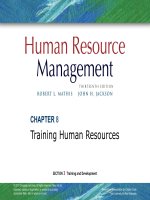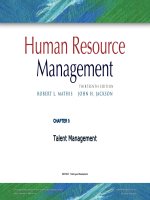Human resrouce management 13th mathis jacson chapter 016
Bạn đang xem bản rút gọn của tài liệu. Xem và tải ngay bản đầy đủ của tài liệu tại đây (1.21 MB, 35 trang )
CHAPTER 16
Union/Management Relations
SECTION 5 Employee Relations
© 2011 Cengage Learning. All rights reserved. May not be
scanned, copied or duplicated, or posted to a publicly
accessible Web site, in whole or in part.
PowerPoint Presentation by Charlie Cook
The University of West Alabama
Chapter Objectives
After you have read this chapter, you should be able to:
• Describe what a union is and explain why employees
join and employers resist unions.
• Identify several reasons for the decline in union
membership.
• Explain the nature of each of the major U.S. labor laws.
• Discuss the stages of the unionization process.
• Describe the typical collective bargaining process.
• Define grievance and identify the stages in a grievance
procedure.
Nature of Unions
• Union
A formal association of workers that promotes the
interests of its members through collective action.
• Why Employees Unionize
They are dissatisfied with how they are treated by
their employers.
They believe that unions can improve their work
situations.
FIGURE 16–1
Factors Leading to Employee Unionization
Nature of Unions (cont’d)
• Why Employers Resist Unions
Unionization constrains what managers can and
cannot do in a number of areas.
Unionization can result in higher wages and benefits.
FIGURE 16–2
Union Membership as a Percentage
of the U.S. Civilian Workforce
Source: U.S. Department of Labor, Bureau of Labor Statistics, 2010.
Unions Globally
• Union membership is falling in advanced
countries.
High unemployment is creating pressure for change.
• In some countries, unions are closely tied to
political parties.
• Child labor is an issue in some countries.
• Co-determination
A practice whereby union or worker representatives
are given positions on a firm’s board of directors.
U.S. and Global Differences in
Union-Management Relations
Key
Differences
Focus on
Economic
Issues
Organization
by Job and
Employer
Collective
Agreements as
“Contracts”
Competitive
Relations
Reasons for U.S. Union Membership Decline
Causes of Membership Decline
Geographic
Changes
Industrial
Changes
Workforce
Changes
FIGURE 16–3
Union Membership by Industry
Source: U.S. Department of Labor, Bureau of Labor Statistics, 2010.
Union Targets for Membership Growth
Focus of Union Organizing
Health Care
Professionals
Low-Skill
Workers and
Immigrants
Contingent and
Part-Time
Workers
Historical Evolution of U.S. Unions
• 1794
Shoemakers’ strike
• 1806
Shoemakers’ strike (“criminal conspiracy”)
• 1886
American Federation of Labor (AFL)
• 1938
Congress of Industrial Organizations (CIO)
• 1957
AFL-CIO merger
• 2005
Change to Win Federation (CTWF)
Union Structure
• Craft Union
A union whose members do one type of work, often
using specialized skills and training.
• Industrial Union
A union that includes many persons working in the
same industry or company regardless of jobs held.
• Federation
A group of autonomous national and international
unions.
• National and International Unions
Groups of local union units
Union Structure (cont’d)
• Local Union
A union centered around either a particular employer
or a particular geographic location.
• Business Agent
A full-time union official who operates the union office
and assists union members.
• Union Stewart
An employee elected by local members to serve as
the first-line representative of unionized employees.
U.S. Labor Laws
• 1926
• 1932
• 1935
Railway Labor Act (RLA)
Norris-LaGuardia Act
National Labor Relations Act (Wagner Act)
• 1947
Taft-Hartley Act
• 1959
Union conduct
National emergency strikes
Right-to-work
Landrum-Griffin Act
• 1978
Employee rights to organize
Employer unfair labor practices
National Labor Relations Board
Union democracy restored
Civil Service Reform Act
FIGURE 16–4
Major National Labor Laws
Employer Unfair Labor Practices
• Interfering with the organizing and collective
bargaining rights of employees.
• Dominating or interfering with any labor
organization.
• Encouraging or discouraging membership in a
particular union.
• Discharging persons for organizing activities or
union membership.
• Refusing to bargain collectively.
Taft-Hartley (Labor-Management Relations) Act
• Right-to-Work Laws
State laws that prohibit contracts requiring employees to join
unions to obtain or continuing employment.
Types of
Shops
Closed Shop
Union Shop
Agency Shop
Maintenanceof-Membership
Shop
FIGURE 16–5
Right-to-Work States
FIGURE 16–6
Typical Unionization
Process
Organizing Campaign
Holding mandatory
employee meetings.
Employers’ Union
Prevention Efforts
Distributing anti-union
leaflets and letters
Anti-union videos, e-mails,
and other electronic means.
Unions’ Organizing Efforts
Authorization
Cards
Salting
Unionization
Efforts
Contract
Negotiation
Bargaining Unit
Composition
Certification
and
Decertification
Bargaining Unit Composition
• “Community of Interest”
Wages, hours, and working conditions
Traditional industry groupings for bargaining purposes
Physical location and amount of interaction and
working relationships among employee groups
Supervision by similar levels of management
• Supervisors and Union Ineligibility
Supervisors are excluded from bargaining units.
FIGURE 16–7
Continuum of Collective Bargaining Relations
Collective Bargaining Issues
Management Rights
Bargaining
Issues
Union Security
(dues checkoff)
Classification of
Bargaining Issues









